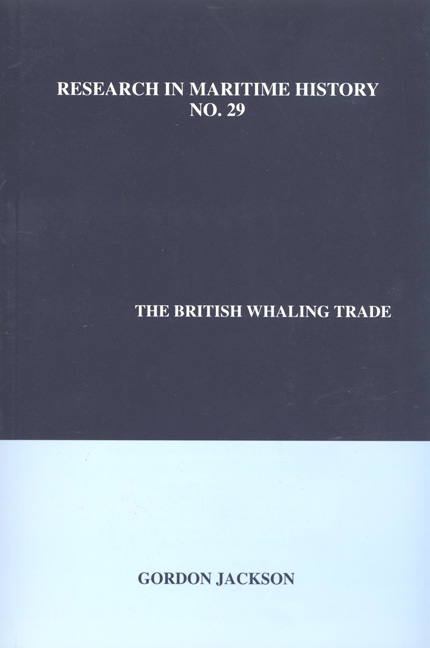Book contents
- Frontmatter
- Dedication
- Contents
- List of Tables in the Text
- List of Appendices
- New Introduction
- Preface
- Part One The Traditional Whaling Trades, 1604-1914
- Chapter 1 Northern Adventures and the Spitsbergen Trade, c. 1604-1670
- Chapter 2 Lost Hopes and Expensive Failures, c. 1670-1750
- Chapter 3 The Rise of the Greenland Trade, 1750-1783
- Chapter 4 The Boom in the Northern Fishery, 1783-c. 1808
- Chapter 5 Expansion South of the Arctic Seas, c. 1776-c. 1808
- Chapter 6 Decline in the North in the Early Nineteenth Century
- Chapter 7 Expansion and Failure of the Southern Fishery, c. 1808-1840
- Chapter 8 The End of the Northern Fishery in the late Nineteenth Century
- Part Two The Modern Whaling Trade, 1904-1963
- Conclusion
- Appendices
- Select Bibliography
- Additional Bibliography
- Index
Chapter 5 - Expansion South of the Arctic Seas, c. 1776-c. 1808
from Part One - The Traditional Whaling Trades, 1604-1914
- Frontmatter
- Dedication
- Contents
- List of Tables in the Text
- List of Appendices
- New Introduction
- Preface
- Part One The Traditional Whaling Trades, 1604-1914
- Chapter 1 Northern Adventures and the Spitsbergen Trade, c. 1604-1670
- Chapter 2 Lost Hopes and Expensive Failures, c. 1670-1750
- Chapter 3 The Rise of the Greenland Trade, 1750-1783
- Chapter 4 The Boom in the Northern Fishery, 1783-c. 1808
- Chapter 5 Expansion South of the Arctic Seas, c. 1776-c. 1808
- Chapter 6 Decline in the North in the Early Nineteenth Century
- Chapter 7 Expansion and Failure of the Southern Fishery, c. 1808-1840
- Chapter 8 The End of the Northern Fishery in the late Nineteenth Century
- Part Two The Modern Whaling Trade, 1904-1963
- Conclusion
- Appendices
- Select Bibliography
- Additional Bibliography
- Index
Summary
For most people in the eighteenth century, and for most British people to this day, the whaling trade was synonymous with the Arctic voyages about which almost all the British whaling histories have been written. It is, however, important to remember that, despite its dramatic potential and home-spun quality, the Northern trade was no more than a subsidiary source of whale oil in the eighteenth century. Before 1770 it was rare for more than a tenth of peace-time imports to come from Greenland, and until the American Revolution the bulk of supplies came from the New England colonies. Imports from there averaged 3696 tuns in the years 1764-1775 compared with only 1168 tuns from Greenland. The Northern Fishery was naturally encouraged by the turmoil of the Revolutionary war, but from the same war sprang another serious rival: the Southern Fishery. They were official designations, the former covering the area north of 59° 30’ in which the whaling bounty was payable, and the latter covering the area south of this where only a token subsidy was given in the form of premiums of £500, £400, £300, £200 and £100 for the five best-fished ships. (See pp. 66-67).
Once the mercantile consequences of rebellion were realised, the American whalermen had moved north or south in an attempt to remain loyal. The Nantucket men, it was later reported, “are dispersed over America and Europe - one half of them died during the war.” Some moved northward and helped to build up the whaling industry in Newfoundland or settled at Dartmouth in Nova Scotia. Others, while continuing to fish in the ocean between Cape Verde and Brazil in latitudes 31° to 36°S, moved to London and so established the Southern Fishery in England. The chief of the newcomers, and spokesmen for the trade for the rest of the century, was the Enderby family of Boston, Massachusetts. Samuel Enderby and his sons - one bearing his name - arrived in London in 1775, together with Alexander Champion and his son - “a well informed intelligent young man” - and John St. Barbe, a naval lieutenant “of a very active enterprising adventurous disposition.” In the following year, using American vessels and crews, they equipped twelve whalers which returned with 439 tuns of oil and were pronounced a success, Enderbys’ three ships alone earning £6676 gross and premiums worth £900.
- Type
- Chapter
- Information
- The British Whaling Trade , pp. 81 - 104Publisher: Liverpool University PressPrint publication year: 2004



